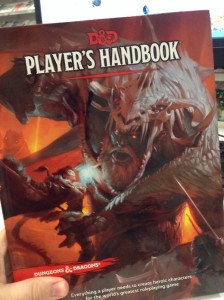Not sure if I mentioned, but earlier this week I picked up the new D&D 5th Edition Starter Set. I’ve been trying to decide what to send my nephew. 1st, 2nd, or 5th Edition. The Starter Set is only $20 (even less on Amazon.com), so I decided to just check it out.
The game mechanics are a bit different, but all the essential elements are there. I like it that they have included rules for using non-combat abilities and skills, like every good RPG since the old days has done. That is an improvement for sure, and very good for role playing.
Combat, in some ways, is greatly simplified. The higher the Armor Class, the better the armor (a huge change, actually). So for any character, the base roll to hit, say AC 18, is an 18. That number is then modified by level bonuses, specialization, etc, etc, etc. So there’s no big table to cross reference like in 1st edition. I actually like the THAC0 system in 2nd Edition, but I must admit it was still kind of convoluted.
Magic users are not quite as weak at 1st level. They have a d6 for hit dice, rather than d4, and have more spells and whatnot. I always preferred to play Magic Users, so this is kind of cool. Oh, they don’t call the character class “Magic User” anymore. It’s Mage, or Wizard, or something.
There are other differences, and I’m sure more will come to light as the new Players Handbook, Monster Manual, and DMG are released.
Now…do I still personally prefer 1st and 2nd Editions? Yes. So far the new version seems pretty good, but there is still something that rubs me the wrong way. Perhaps I’m just being silly about this, but the “slickness” of the new game design and the actual materials is clearly the product of a division of a big company, not a few guys sitting at a table making up a new game. However, I spent some time getting up to speed on the history of 5th Edition, the crowd-sourcing they used to help design it, and it seems like the folks working on the game are real gamers who really love RPGs. There are some features I’ve seen in info released from the upcoming Players Handbook that I don’t like a lot. I’m not crazy about some of the stuff they’ve done for character classes and backgrounds. Some of it frankly seems like stuff you’d see in a card game or video game. But that’s the era we’re living in, and they want to sell some books and make some money, so whatever.
I’m not a game design professional. I think this new version will probably appeal a lot more to current young gamers than to old guys like me. If they seek to please people like me, they will be pleasing a very happy but dying market. Not a good business model.
So, I’ve just sent a copy of the new Starter Set to my nephew. I think he will enjoy it. I think the materials, the quality and presentation of it all, will speak to a kid of his generation. I can easily learn the game mechanics and help him out if he needs help. So if he digs the Starter Set and gets a little game time in, I’ll send him the three new core books as they are released, and get them for myself for reference.
Like this:
Like Loading...

